Page 763 of 840
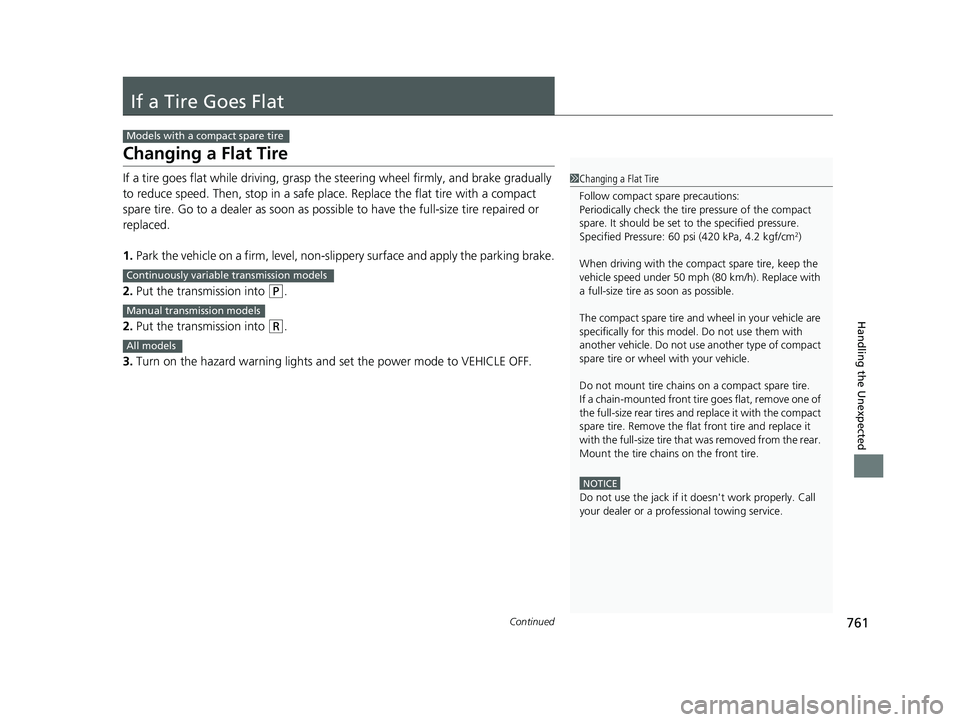
761Continued
Handling the Unexpected
If a Tire Goes Flat
Changing a Flat Tire
If a tire goes flat while driving, grasp the steering wheel firmly, and brake gradually
to reduce speed. Then, stop in a safe plac e. Replace the flat tire with a compact
spare tire. Go to a dealer as soon as possib le to have the full-size tire repaired or
replaced.
1. Park the vehicle on a firm, level, non-slippery surface and apply the parking brake.
2. Put the transmission into
(P.
2. Put the transmission into
(R.
3. Turn on the hazard warning lights an d set the power mode to VEHICLE OFF.
Models with a compact spare tire
1Changing a Flat Tire
Follow compact spare precautions:
Periodically check the tire pressure of the compact
spare. It should be set to the specified pressure.
Specified Pressure: 60 psi (420 kPa, 4.2 kgf/cm
2)
When driving with the compact spare tire, keep the
vehicle speed under 50 mph (80 km/h). Replace with
a full-size tire as soon as possible.
The compact spare tire and wheel in your vehicle are
specifically for this model. Do not use them with
another vehicle. Do not us e another type of compact
spare tire or wheel with your vehicle.
Do not mount tire chains on a compact spare tire.
If a chain-mounted front tire goes flat, remove one of
the full-size rear tires and replace it with the compact
spare tire. Remove the flat front tire and replace it
with the full-size tire that was removed from the rear.
Mount the tire chains on the front tire.
NOTICE
Do not use the jack if it doesn't work properly. Call
your dealer or a prof essional towing service.
Continuously variable transmission models
Manual transmission models
All models
23 CIVIC HATCHBACK TYPE R-31T406100_03.book 761 ページ 2022年6月23日 木曜日 午後9時28分
Page 768 of 840
uuIf a Tire Goes Flat uChanging a Flat Tire
766
Handling the Unexpected
1. Remove the center cap.
2. Place the flat tire face down in the spare tire
well.
3. Remove the spacer cone from the wing
bolt, flip it over, and insert it back on the
bolt. Secure the flat tire with the wing bolt.
4. Securely store the jack, wheel nut wrench,
and jack handle bar back in the tool case.
Store the case in the cargo area.
■Storing the Flat Tire1Storing the Flat Tire
3WARNING
Loose items can fly around the interior in a
crash and can seriously injure the
occupants.
Store the wheel, jack, and tools securely
before driving.
Center Cap
Spacer Cone
Wing Bolt
For
compact
spare tireFor full-
size tire
23 CIVIC HATCHBACK TYPE R-31T406100_03.book 766 ページ 2022年6月23日 木曜日 午後9時28分
Page 769 of 840
767
uuIf a Tire Goes Flat uChanging a Flat Tire
Handling the Unexpected
If you replace a flat tire with the spare tire, the low tire pressure/TPMS indicator
comes on while you are driving. After driving for a few miles (kilometers), Tire
pressure monitor system problem. Check tire pressure. See your dealer. will
appear on the driver information interfac e and the indicator will start blinking for a
short time and then stay on; however, this is normal and is no cause for concern.
Calibrate the TPMS when you replace the tire with a specified regular tire.
2TPMS Calibration P. 541
■TPMS and the Compact Spare Tire
U.S. models
23 CIVIC HATCHBACK TYPE R-31T406100_03.book 767 ページ 2022年6月23日 木曜日 午後9時28分
Page 770 of 840
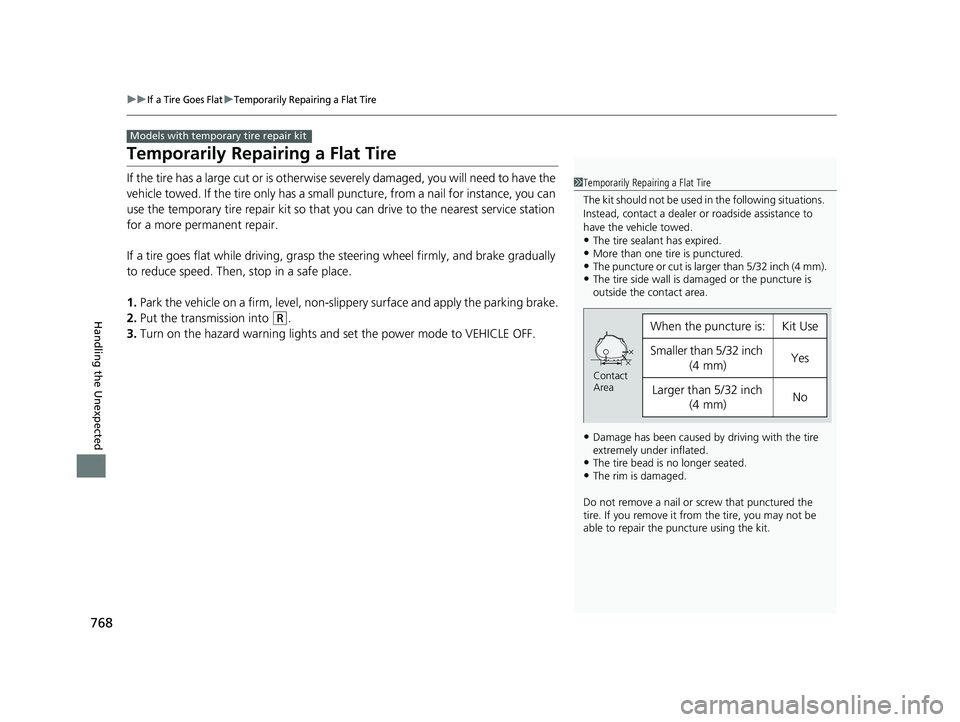
768
uuIf a Tire Goes FlatuTemporarily Repairing a Flat Tire
Handling the Unexpected
Temporarily Repairing a Flat Tire
If the tire has a large cut or is otherwise severely damaged, you will need to have the
vehicle towed. If the tire only has a smal l puncture, from a nail for instance, you can
use the temporary tire repair kit so that you can drive to the nearest service station
for a more permanent repair.
If a tire goes flat while driving, grasp the steering wheel firmly, and brake gradually
to reduce speed. Then, stop in a safe place.
1. Park the vehicle on a firm, level, non-slippery surface and apply the parking brake.
2. Put the transmission into
(R.
3. Turn on the hazard warning lights an d set the power mode to VEHICLE OFF.
Models with temporary tire repair kit
1Temporarily Repairing a Flat Tire
The kit should not be used in the following situations.
Instead, contact a dealer or roadside assistance to
have the vehicle towed.
•The tire sealant has expired.•More than one tire is punctured.•The puncture or cut is larger than 5/32 inch (4 mm).•The tire side wall is da maged or the puncture is
outside the contact area.
•Damage has been caused by driving with the tire
extremely under inflated.
•The tire bead is no longer seated.•The rim is damaged.
Do not remove a nail or screw that punctured the
tire. If you remove it from the tire, you may not be
able to repair the puncture using the kit.
When the puncture is:Kit Use
Smaller than 5/32 inch
(4 mm)Yes
Larger than 5/32 inch (4 mm)No
Contact
Area
23 CIVIC HATCHBACK TYPE R-31T406100_03.book 768 ページ 2022年6月23日 木曜日 午後9時28分
Page 778 of 840
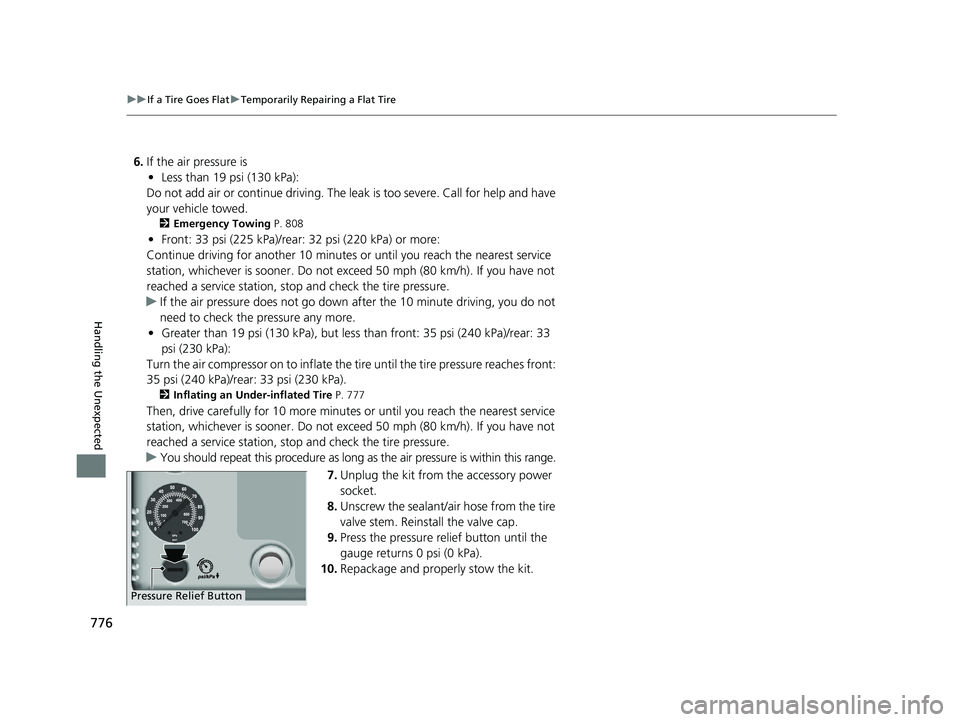
776
uuIf a Tire Goes Flat uTemporarily Repairing a Flat Tire
Handling the Unexpected
6. If the air pressure is
• Less than 19 psi (130 kPa):
Do not add air or continue driving. The leak is too severe. Call for help and have
your vehicle towed.
2 Emergency Towing P. 808
•Front: 33 psi (225 kPa)/rear: 32 psi (220 kPa) or more:
Continue driving for another 10 minutes or until you reach the nearest service
station, whichever is sooner. Do not exce ed 50 mph (80 km/h). If you have not
reached a service station, stop and check the tire pressure.
u If the air pressure does not go down after the 10 minute dr iving, you do not
need to check the pressure any more.
• Greater than 19 psi (130 kPa), but less than front: 35 psi (240 kPa)/rear: 33
psi (230 kPa):
Turn the air compressor on to inflate the tire until the tire pressure reaches front:
35 psi (240 kPa)/rear: 33 psi (230 kPa).
2 Inflating an Under-inflated Tire P. 777
Then, drive carefully for 10 more minutes or until you reach the nearest service
station, whichever is sooner. Do not exce ed 50 mph (80 km/h). If you have not
reached a service station, stop and check the tire pressure.
u You should repeat this procedure as long as the air pressure is within this range.
7. Unplug the kit from the accessory power
socket.
8. Unscrew the sealant/air hose from the tire
valve stem. Reinstall the valve cap.
9. Press the pressure relief button until the
gauge returns 0 psi (0 kPa).
10. Repackage and properly stow the kit.
Pressure Relief Button
23 CIVIC HATCHBACK TYPE R-31T406100_03.book 776 ページ 2022年6月23日 木曜日 午後9時28分
Page 787 of 840
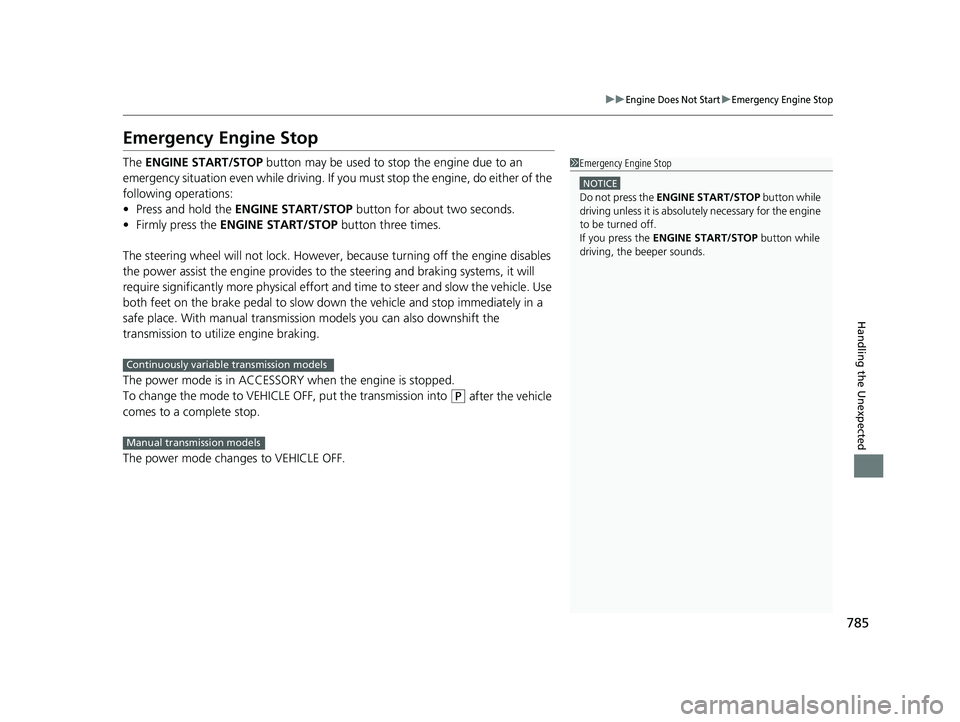
785
uuEngine Does Not StartuEmergency Engine Stop
Handling the Unexpected
Emergency Engine Stop
The ENGINE START/STOP button may be used to stop the engine due to an
emergency situation even while driving. If you must stop the engine, do either of the
following operations:
• Press and hold the ENGINE START/STOP button for about two seconds.
• Firmly press the ENGINE START/STOP button three times.
The steering wheel will not lock. However, because turning off the engine disables
the power assist the engine provides to the steering and braking systems, it will
require significantly more physical effort an d time to steer and slow the vehicle. Use
both feet on the brake pedal to slow down the vehicle and stop immediately in a
safe place. With manual transmission models you can also downshift the
transmission to utilize engine braking.
The power mode is in ACCESSORY when the engine is stopped.
To change the mode to VEHICLE OFF, put the transmission into
(P after the vehicle
comes to a complete stop.
The power mode changes to VEHICLE OFF.
1 Emergency Engine Stop
NOTICE
Do not press the ENGINE START/STOP button while
driving unless it is absolute ly necessary for the engine
to be turned off.
If you press the ENGINE START/STOP button while
driving, the beeper sounds.
Continuously variable transmission models
Manual transmission models
23 CIVIC HATCHBACK TYPE R-31T406100_03.book 785 ページ 2022年6月23日 木曜日 午後9時28分
Page 794 of 840
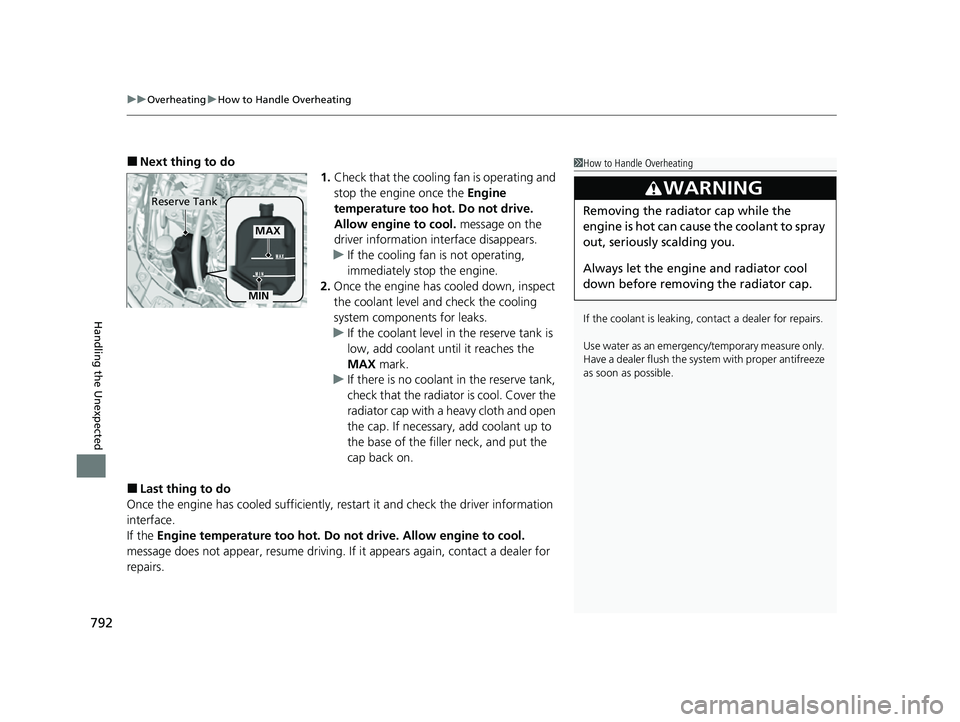
uuOverheating uHow to Handle Overheating
792
Handling the Unexpected
■Next thing to do
1.Check that the cooling fan is operating and
stop the engine once the Engine
temperature too hot. Do not drive.
Allow engine to cool. message on the
driver information interface disappears.
u If the cooling fan is not operating,
immediately stop the engine.
2. Once the engine has cooled down, inspect
the coolant level an d check the cooling
system components for leaks.
u If the coolant level in the reserve tank is
low, add coolant until it reaches the
MAX mark.
u If there is no coolan t in the reserve tank,
check that the radiator is cool. Cover the
radiator cap with a heavy cloth and open
the cap. If necessary, add coolant up to
the base of the filler neck, and put the
cap back on.
■Last thing to do
Once the engine has cooled sufficiently, re start it and check the driver information
interface.
If the Engine temperature too hot. Do not drive. Allow engine to cool.
message does not appear, resume driving. If it appears again, contact a dealer for
repairs.
1 How to Handle Overheating
If the coolant is leaking, contact a dealer for repairs.
Use water as an emergency/temporary measure only.
Have a dealer flush the system with proper antifreeze
as soon as possible.
3WARNING
Removing the radiator cap while the
engine is hot can cause the coolant to spray
out, seriously scalding you.
Always let the engine and radiator cool
down before removing the radiator cap.
MAX
Reserve Tank
MIN
23 CIVIC HATCHBACK TYPE R-31T406100_03.book 792 ページ 2022年6月23日 木曜日 午後9時28分
Page 796 of 840
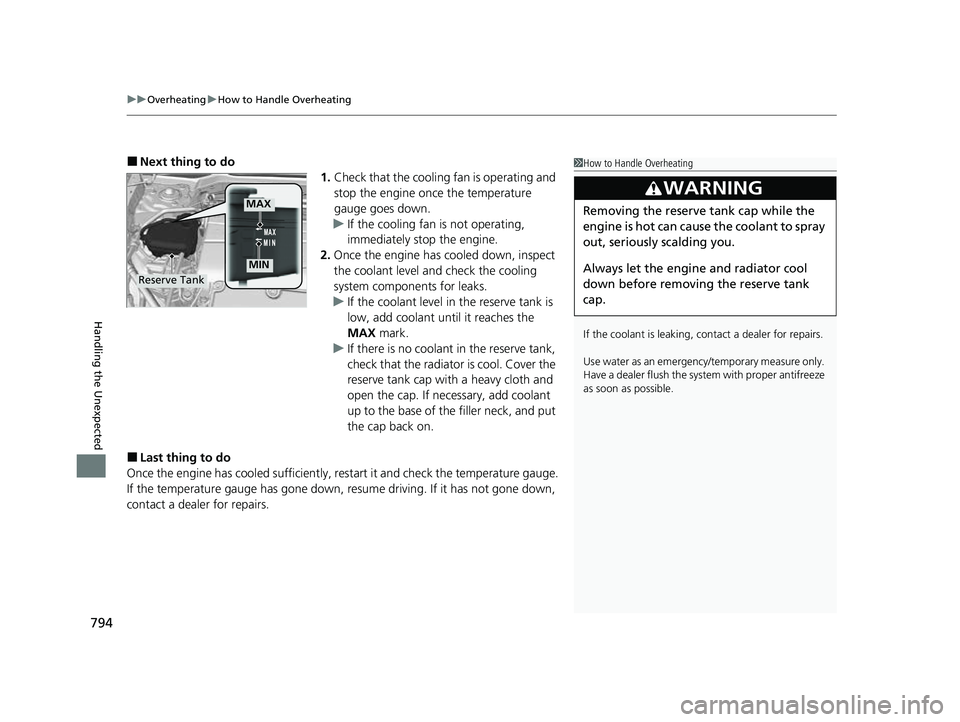
uuOverheating uHow to Handle Overheating
794
Handling the Unexpected
■Next thing to do
1.Check that the cooling fan is operating and
stop the engine once the temperature
gauge goes down.
u If the cooling fan is not operating,
immediately stop the engine.
2. Once the engine has cooled down, inspect
the coolant level an d check the cooling
system components for leaks.
u If the coolant level in the reserve tank is
low, add coolant until it reaches the
MAX mark.
u If there is no coolan t in the reserve tank,
check that the radiator is cool. Cover the
reserve tank cap with a heavy cloth and
open the cap. If necessary, add coolant
up to the base of the filler neck, and put
the cap back on.
■Last thing to do
Once the engine has cooled sufficiently, restart it and check the temperature gauge.
If the temperature gauge has gone down, re sume driving. If it has not gone down,
contact a dealer for repairs.
1 How to Handle Overheating
If the coolant is leaking, contact a dealer for repairs.
Use water as an emergency/temporary measure only.
Have a dealer flush the system with proper antifreeze
as soon as possible.
3WARNING
Removing the reserve tank cap while the
engine is hot can cause the coolant to spray
out, seriously scalding you.
Always let the engine and radiator cool
down before removing the reserve tank
cap.MAX
Reserve Tank
MIN
23 CIVIC HATCHBACK TYPE R-31T406100_03.book 794 ページ 2022年6月23日 木曜日 午後9時28分